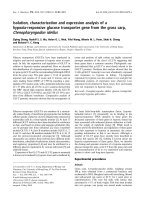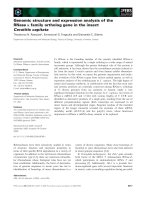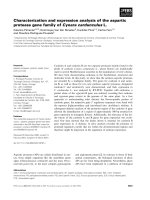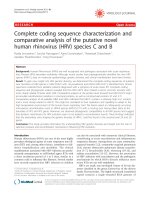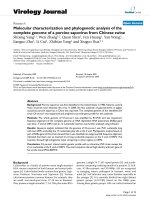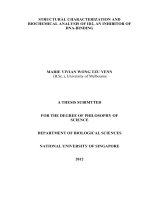Molecular characterization and developmental analysis of interferon regulatory factor 6 (IRF6) gene in zebrafish
Bạn đang xem bản rút gọn của tài liệu. Xem và tải ngay bản đầy đủ của tài liệu tại đây (6.78 MB, 149 trang )
MOLECULAR CHARACTERIZATION AND
DEVELOPMENTAL ANALYSIS OF INTERFERON
REGULATORY FACTOR 6 (IRF6) GENE IN ZEBRAFISH
BEN JIN
NATIONAL UNIVERSITY OF SINGAPORE
2006
MOLECULAR CHARACTERIZATION AND
DEVELOPMENTAL ANALYSIS OF INTERFERON
REGULATORY FACTOR 6 (IRF6) GENE IN ZEBRAFISH
BEN JIN
(M.Sc., National University of Singapore)
A THESIS SUBMITTED
FOR THE DEGREE OF DOCTOR OF PHILOSOPHY
DEPARTMENT OF PAEDIATRICS
NATIONAL UNIVERSITY OF SINGAPORE
2006
ACKNOWLEDGEMENT
I wish to express my cordially gratitude to my supervisor, Associate Professor Samuel S.
Chong for the guidance in this Ph.D. pursuing. His direction, criticisms, encouragement,
patience and incessant push powerfully support me to go through the whole process of
this study.
I would like to acknowledge Drs. Karuna Sampath, Korzh Vladmir, Yiwen Liu, Peng
Jingrong, Wen Zilong and their group members for offering the reagents and technical
assistance.
I would like to give my thanks to Drs. Violet P.E. Phang and Dong Liang for the
suggestion and encouragement.
I would sincerely appreciate the colleagues, Siew Hong Cheah, Wen Wang, Yayun
Yang, Arnold Tan for the material and technical support, collaboration and lab
maintenance.
Finally, I would like to appreciate my mother and father. Their love and their
enthusiasms
on scientific truth accompany me and initiate my career in science.
i
CONTENTS
Page
No.
ACKNOWLEDGEMENT
i
TABLE OF CONTENTS
ii
SUMMARY
v
LIST OF TABLES
vii
LIST OF FIGURES
viii
CHAPTER 1 GENERAL INTRODUCTION
1
1.
Human Genetic Diseases/Inherited disorders
1
2.
Animal models for interpretation of human
genome and genetic diseases
2
2.1
Zebrafish as a model for Human disorders
3
2.1.1
Forward genetics - Mutagenesis
4
2.1.2
Reverse genetics - Perturbation of gene of
interest
5
2.1.2.1
Gain of function
6
2.1.2.2
Loss of function by knockdown
7
2.1.2.3
Loss of function - dominant negative
perturbation
8
2.1.3
Developmental studies of digestive organs
using zebrafish
9
2.1.3.1
Gut
9
2.1.3.2
Liver and pancreas
10
2.1.3.3
Molecular pathways regulating the
development of the digestive system
13
2.1.4
Studies of craniofacial development using
zebrafish
17
2.1.5
Molecular markers for expression analysis of
phenotypes
19
2.2
Mouse
22
2.3
Chick
22
2.4
Xenopus
23
3.
Human Van der Woude (VWS) and popliteal
pyterygium syndromes (PPS)
23
3.1
Orocleft disorders
23
3.2
VWS and PPS
24
4.
IRF6
25
4.1
IRFs
25
4.2
IRF6
27
5.
Objectives of characterization of zebrafish irf6
29
CHAPTER 2 MATERIALS AND METHODS
32
1.
Zebrafish strains
32
2.
Isolation of total RNA and Genomic DNA
32
3.
Full-length cDNA cloning
33
ii
4.
Phylogenetic analysis
37
5.
Promoter cloning
37
6.
Identification of Genomic structure
38
7.
Chromosome mapping
42
8.
The probe syntheses for in situ RNA
hybridization analysis
42
9.
Whole mount RNA in situ hybridization
44
10.
Cryosection
47
11.
Paraffin section
48
12.
H and E staining
48
13.
Head cartilage detection with alcian blue
staining
49
14.
Staining of red blood cells
50
15.
Image process
51
16.
Microinjection
51
17.
Knockdown analysis
52
18.
Dominant negative perturbation and ectopic
expression
54
19.
Detection of putative promoter
55
20.
Western Blot to detect Irf6 protein
56
CHAPTER 3 RESULTS
58
1.
Characterization of the full-length zebrafish
irf6 cDNA
58
2.
Genomic organization and map location of
zebrafish irf6
63
3.
Developmental expression pattern of irf6
69
4.
Effectiveness of morpholino knockdowns and
dominant negative perturbation
75
5.
Phenotypes of irf6 morpholino knockdown
and dominant negative perturbation.
82
6.
The expression of molecular markers
shows the organogenesis affected by irf6
89
7.
Defective pharyngeal arches in loss of irf6
function larvae
96
8.
Expression of EGFP driven by the 4 kb irf6
promoter
99
CHAPTER 4 DISCUSSION AND CONCLUSION
106
1.
Zebrafish Irf6 and its cDNA
106
2.
Conserved genomic structures of IRF6 gene
among organisms
106
3.
Comparison of IRF6 expression patterns
107
4.
The association of irf6 expression and human
VWS and PPS disorders.
109
5.
Loss of function analysis
110
5.1
Phenotypes of morphants and dominant
110
iii
negative perturbation
5.2
Loss of irf6 function causes digestive organs
under-develop
112
5.3
Loss of irf6 function leads to deforms in
pharyngeal arches
114
5.4
Loss of irf6 function does not produce the
zebrafish that phenocopy Van der Woude
syndrome or Popliteal Pterygium syndrome
114
6.
Two forms of irf6 Intron 1
117
7.
Anti- G
124
SVPTYETDGDEDDI
138
polyclonal
antibody can not work in Western Blot
analysis
117
8.
Conclusion and Future studies
118
8.1
Genomic and transcript information of irf6
and its expression pattern
118
8.2
irf6 affects the digestive and pharyngeal arch
organogenesis
112
8.3
Clinical significance of perturbation of
zebrafish irf6
119
8.4
Unknown interacting partners of Irf6
120
8.5
Is Irf6 an activator or repressor, and what are
the genes regulated by Irf6
120
8.6
What are those transcription factors
regulating irf6 expression
121
REFERENCES
122
iv
SUMMARY
Van der Woude syndrome (VWS) and popliteal pterygium syndrome (PPS) are
autosomal dominant clefting disorders recently discovered to be caused by mutations in
the IRF6 (Interferon Regulatory Factor 6) gene. The IRF gene family consists of nine
members encoding transcription factors that share a highly conserved helix-turn-helix
DNA-binding domain and a less conserved protein-binding domain. Most IRFs regulate
the expression of interferon-α and -β after viral infection; however, the function of IRF6
remains unknown. In this project, a full length zebrafish irf6 cDNA was isolated. It
encodes a 492 amino acid protein that contains a protein-IRF interaction motif and a
DNA-binding domain. The zebrafish irf6 gene was identified to consist of eight exons
and maps to linkage group 22 closest to marker unp1375. The in situ hybridization
analysis of whole mounts and cryosections demonstrates that irf6 was first expressed as a
maternal transcript. During gastrulation, irf6 expression was concentrated in the
forerunner cells. From the bud stage to the 3-somite stage, irf6 expression was observed
in the Kupffer’s vesicle. No expression could be detected at the 6-somite and 10-somite
stages. At the 14-somite stage, expression was detected in the otic placode. At the 17-
somite stage, strong expression was also observed in the cloaca. During the pharyngula,
hatch and larva periods up to 5 days post-fertilization, irf6 was expressed in the
pharyngeal arches, olfactory and otic placodes, and in the epithelial cells of endoderm
derived tissues. The latter tissues include the mouth, pharynx, esophagus, endodermal
lining of swim bladder, liver, exocrine pancreas, and associated ducts. The zebrafish
expression data are consistent with the observations of lip pits in VWS patients, as well
v
as more recent reports of alae nasi, otitis media and sensorineural hearing loss
documented in some patients. The translation-blocking and splice-modifying
morpholino-mediated gene knockdown analyses were performed to observe the effect of
reduction or loss of Irf6 function on organogenesis during zebrafish embryonic
development. Additionally, microinjection of capped mRNA carrying an Arg84 to Cys
(R84C) dominant-negative point mutation was performed. All loss of function treatments
produced larvae with identical gross morphologies, including bloated abdomen, small
eyes and head, and delayed yolk resorption. Major pharyngeal arch deformities were
observed, including misalignments, degenerations and absent structures. Furthermore,
the liver and pancreas were reduced in size compared to wildtype fish. The intestinal
lumen was constricted, with absent or reduced folding of the epithelial cell monolayer.
The epithelial cells of the intestine maintained their cuboidal shape, with the nuclei still
situated in the center and not the base of the cells. A milder phenotype showing reddish
intestine was observed in larvae injected with splice-modifying morpholinos and
dominant negative perturbation. By the inspiration that both irf6 and sox17 have the
expression in the forerunner cells and endoderm organs, we propose and test the
hypothesis that Irf6 is an effector of Nodal signaling pathway, upstream or downstream
of sox17. However, our results do not support this hypothesis.
vi
LIST OF TABLES
Table
No.
Page
No.
2.1 Primer pairs for PCR detection of introns.
41-42
2.2 The syntheses of RNA probes and in situ hybridization
conditions.
47
3.1 Percentage amino acid similarity of zebrafish IRF6 compared
with other species.
61
3.2 Summary of rescue experiments for morpholino knockdown.
82-83
3.3 Phenotypes of Loss of irf6 function.
88
vii
LIST OF FIGURES
3.7 Whole-mount (A-I) and sagittal section (J-L) analysis of irf6
expression in early zebrafish embryos.
71-72
3.8 Expression of irf6 transcript in the developing zebrafish
during pharyngula, hatching and larval stages.
73-74
3.9 The antibody targeting to the Irf6 epitope
G
124
SVPTYETDGDEDDI
138
is not specific to detect the Irf6
protein in the Western Blot analysis.
75
Fig.
No.
Page No.
1.1
Flowchart of characterization of irf6 using zebrafish
model.
31
2.1 Amplification of irf6 cDNA from AB line zebrafish embryos
at the age of 24 hpf old.
37
2.2 Amplification of the putative irf6 promoter fragments using
Universal GenomeWalker™ kit.
38
2.3 Diagram of putative genomic structure and the PCR detection
of exon-intron junction using primers.
40-41
2.4 (A) PCR fragment amplified from genomic DNA using PaeI-
IRF-Pf4 and BamHI-5’E2r primers. (B) Expression plasmid
to detect the cis-elements upstream of irf6 coding region.
57
Full-length nucleotide sequence of zebrafish irf6 cDNA and
its deduced amino acid sequence.
58-59 3.1
Phylogenetic analysis of the IRF gene family.
60 3.2
3.3 Alignment of the predicted IRF6 proteins from five species.
62
3.4 Genomic organization of the IRF6 orthologs in human,
mouse, Fugu, and zebrafish.
63-64
3.5 Assembled sequences of irf6 genomic fragments.
64-66
3.6 The irf6 gene locus on the LG22 in T51 RH panel and in the
Ensembl zebrafish version 6 (ZV6).
68-69
viii
3.10 Effectiveness of irf6 translation-block morpholinos.
77-78
3.11 Effectiveness of irf6 splicing-modified morpholino E4I4
79-80
Fig.
No.
Page No.
3.12 in vitro translation of capped mRNAs for the expression of
wildtype
81
3.13
Non-specific phenotypes caused by over-dosage of
morpholinos.
85
3.14 Loss of irf6 function phenotypes
86-87
3.15 Comparison of expression of molecular markers in irf6
morphants and wildtype.
91-92
3.16 Hematoxylin and eosin staining of intestines sections of irf6
morphants and wildtype.
93-95
3.17 Alcian blue staining analysis of the effects of loss of irf6
function on zebrafish head cartilages.
97-98
3.18 (A) The sequence of putative irf6 promoter fragment
amplified with IRF-Pf4 and 5’E2r. (B) The alignment of two
alternative Intron 1 forms of irf6. (C) Two sizes of PCR
products
99-104
3.19 The EGFP expression in embryos injected with the
expression vector pXD-Ef1α-4kbirf6-EGFPpA.
105
4.1 The locations of peptides used for preparation of anti-IRF
polyclonal antibodies.
118
ix
CHAPTER 1 GENERAL INTRODUCTION
1. Human Genetic Diseases/Inherited disorders
Diseases are caused by the environmental factors like infectious pathogens, chemicals,
nutritions, or interactions between genes and environment, or interactions among
various genes. Inherited disorders occur when abnormalities are present in genome.
The inherited disorders are categorized into four classes: (1) Monogenic. When
mutation occurs in the DNA sequence of single gene, the protein encoded by the gene
can not perform the normal function, leading to a disorder. This kind of monogenic
disorders are transmitted to the progenies in a fashion of Mendel’s law, either
autosomal dominant, autosomal recessive, or sex chromosome-linked (Tamarin,
1999). (2) Polygenic. This type of disorders is generally caused by the combined
interactions among the mutations/polymorphisms in multiple genes and
environmental factors. This multifactorial character makes the diagnosis and the
mechanism identification hard to be analyzed. Generally, the more cases the diseases
are present in population, the more factors are involved in the diseases, for instances,
heart diseases, hypertension, diabetes, arthritis, Parkinson’s disease, autism,
susceptibility to pathogens, and so on (Badano and Katsanis, 2002). (3)
Chromosomal. In the nucleus, chromosomes are composed of DNA and proteins.
Numerous genes are loaded on one chromosome. A disease would happen when the
number of chromosomes changes (aneuploidy), or when the chromosome structure
changes, for instance, lost copies, gained copies or translocations. Some chromosomal
abnormalities can be detected by karotype detection or fluorescence in situ
hybridization (FISH) using microscope (Pasternak, 2005b). (4) Mitochondrial.
Mitochondria is an organelle located in the cell cytoplasm, functioning as the
principal energy source of the cell and containing the cytochrome enzymes of
1
terminal electron transport and the enzymes of the citric acid cycle, fatty acid
oxidation, and oxidative phosphorylation. This organelle has its own DNA pieces in
circular, which are separated from chromosomes. The mitochondrial DNA is
maternally inherited. Some of functional mitochondrial proteins are encoded by
mitochondrial DNA. Therefore, mutations in the nonchromosomal DNA of
mitochondria can cause some genetic disorders, generally muscle disorders (Pasternak,
2005a).
2. Animal models for interpretation of human genome and genetic diseases
Human genome is composed of 22 pairs of autosomes and X and Y chromosomes.
The haploid is long in 3000 Mb. Only 3% of DNA is exon region. The estimated gene
number is about 35,000 (Ewing and Green, 2000). About 30% of DNA is mobile
elements, classified into DNA-based transposable elements, autonomous
retrotransposons, and nonautonomous retrotransposons. The others are composed of
introns, promoters and enhancers, pseudogenes and repeated sequences (Lander et al.,
2001; Venter et al., 2001). The association of the specific genes with diseases through
the Mendelian disorders somehow helps define the functions of corresponding genes.
Some genes when mutated cause lethal effects, or multifactorial disorders. On one
hand, the functional identification of these genes relies on the direct gene sequencing
and sequence variations among populations. On the other hand, in the evolutionary
history, many cell to cell signaling pathways and the regulations of gene expression
required for embryogenesis are functionally conserved among various organisms,
especially vertebrates. Thus, animal models are used to study how the disease
progresses and what factors are associated with the disease process and how the
disease can be treated. Animal mutagenesis is a powerful way to model the human
genetic diseases and therefore complement to human sample resources. After the
2
invertebrate models, Drosophila and C.elegans, the large-scale mutageneses using the
chemical mutagen N-ethyl-N-nitrosourea (ENU), retroviral delivery system and
transposition system have been carried out in the mouse and zebrafish. In addition, the
gene expression patterns and disruption of targeted genes in mouse, chick, and
xenopus establish the association between gene and developmental phenotypes.
2.1 Zebrafish as a model for Human disorders
Although physiological differences exist between fish and human, zebrafish has
advantages to be a disease model to complement to mouse and other animals for
human monogenic diseases. The transparency of embryos and larvae facilitates the
pathological phenotypic screening and disease progression examination directly under
optical microscopes without other complex analysis and equipment. On the other hand,
forward-genetic screening combined with reverse-genetic transient morpholino
knockdown allows the investigation about effects by the various dosage of gene
product. In contrast, in mouse system, only knockout and knockin strategy is available.
That means that phenotypes caused by only half dosage (heterozygous) or zero dosage
(homozygous) of normal gene product can be examined. With the unique
experimental advantages, zebrafish has made major contributions for the
understanding of human disorders and organogenesis related to: craniofacial
development (Neuhauss et al., 1996; Piotrowski et al., 1996; Schilling et al., 1996),
digestive organogenesis (Pack et al., 1996), ear and eye development (Goldsmith and
Harris, 2003; Whitfield, 2002), hematopoietic and cardiovascular disorders (Dooley
and Zon, 2000; North and Zon, 2003), neurodevelopment (Tropepe and Sive, 2003),
hematologic development (Shafizadeh and Paw, 2004), germ cell aneuploidy (Poss,
3
2004), laterality (Peeters and Devriendt, 2006), otoconical development (Hughes et al.,
2006), and nutrient metabolism (Merchant and Sagasti, 2006).
Zebrafish (Danio rerio) is a species belonging to the family Cyprinidae. It is a tropical
omnivorous fish inhabiting in the fresh waters of Pakistan, India, Bangladesh and
Nepal. Zebrafish was first suggested as a system for studies of developmental biology
in 1981 (Streisinger et al., 1981). It got the increasingly attention to become an
experimental organism, because the fish is in small size (up to 6 cm), has a short
generation time (3~4 months), high fecundity (100-200 eggs per mating), external
fertilization, and transparent embryos. Most of the embryonic methodologies to be
routinely applied in Xenopus can be also successfully performed on zebrafish. The
requirement for fish maintenance is far lower than mouse (Detrich, III et al., 1999;
Eisen, 1996).
The genome of zebrafish is being sequenced and mapped. The databases are available
on ZFIN, NCBI and ENSEMBL websites, further facilitating the zebrafish research.
Zebrafish has 25 pairs of chromosomes, very similar to the number of human
chromosomes (23 pairs) (Sola and Gornung, 2001). The drawback of zebrafish as a
model to study the human genetic disorder is the duplication event in genome. The
mapping data indicates that only about 20% of genes keep duplicates, while the
redundancy in the left 80% of genes is lost. The expression of duplicated genes
showed some divergent patterns, suggesting specific functions for each duplicate
(Force et al., 1999; Van de et al., 2002; Taylor et al., 2001).
2.1.1 Forward genetics - Mutagenesis
4
Zebrafish mutants are excellent models for human genetic diseases. Large-scale
mutagenesis was first performed in zebrafish using ENU. The efficiency of
mutagenesis is quite high, at a rate of one to three mutations per locus in every 1,000
haploid genomes (Mullins et al., 1994). The mutations caused the phenotypes of
mutants covering every aspect of development (Driever et al., 1996; Haffter et al.,
1996). However, the following identification of the mutations is a major problem,
because ENU results in point mutations, requiring positional cloning map of the locus
of the genes, followed by mutation scanning of candidate genes within the mapped
region. The procedures are highly complex, laborious and time-consuming.
Alternative efficient mutagenesis strategies were developed to simplify the
identification of disrupted genes. The integration of exogenous DNA segments serves
as the marker tags for the subsequent detection of the flanking host sequences by PCR.
For instance, the high-titer infectious pseudotyped retroviruses were packaged from
recombinant retroviral vectors and were injected into zebrafish embryos. After the
infection, the exogenous retroviral DNA sequences were integrated into the host
genome. The mutations were transmitted to F1 progeny. The homozygous mutants
shall be present in F3 generations by cross of F2 generations. Drawback of retroviral-
mediated mutagenesis is that the efficiency of retroviral-mediated mutagenesis is one-
ninth of the frequency by ENU treatment (Amsterdam et al., 1999; Amsterdam and
Hopkins, 1999; Linney et al., 1999).
2.1.2 Reverse genetics - Perturbation of the gene of interest
The mutagenesis using mutagens like ethyl nitrosourea (ENU) or pseudotyped
retrovirus introduces random mutations, belonging to the forward genetic screen.
5
Once the mutants are constructed, the causative genes for the defective phenotypes
are identified with genetic and molecular methodologies. In contrast to the productive
forward genetic screens, an alternative strategy is to change a gene of interest and
then determine the phenotypes. It is called reverse genetics. In mouse, the transgenic
mouse is constructed by engineering on a particular gene, for instance, deleting the
gene from the genome. The approach is termed as “gene knockout”. The gene
knockouts by homologous recombination have not been achieved in zebrafish because
the culture of embryonic stem cells of zebrafish is not successful at present. To
understand the gene of interest, the strategy is to perturb the activity of gene product
and to see how the phenotypes are affected. The perturbation includes gain-of-
function and loss-of-function (Hammerschmidt et al., 1999).
2.1.2.1 Gain of function
Ectopic expression
Ectopic expression can be performed by microinjecting the synthetic mRNA or
expression vector into zebrafish embryos at 1~4 cell stage. The expression vector has
a ubiquitous promoter to drive the gene product to be present in any cell types from
early moment. The gene of interest can be expressed as early as midblastula stage.
Entopic expression
To study the effect of higher dosage of specific gene in its normal place, the entopic
expression can be performed when the gene-specific promoter is cloned. An
expression vector with the gene-specific promoter and protein-encoding cDNA can be
constructed and injected into embryos.
6
2.1.2.2 Loss of function by knockdown
Repressing gene expression is applied to test the function of a gene in the life of an
organism. Only mutants carrying the deleted or non-sense mutations can abolish the
expression of the gene in whole life. An alternative way to mimic the knockout
animals or mutants is “knockdown”, however, which just transiently inhibits the
expression of specific genes (Nasevicius and Ekker, 2000).
The knockdown can be mediated by two methods, RNA interference (RNAi) and
antisense oligonucleotides. RNAi means that the expression of a specific gene in cells
is interfered through the degradation of mRNA caused by the short homologous
double-stranded RNA (dsRNA). This system is highly efficient when applied in plant,
C. elegans or mammalian cell lines (Chuang and Meyerowitz, 2000; Misquitta and
Paterson, 1999; Montgomery et al., 1998; Wianny and Zernicka-Goetz, 2000). Three
research groups independently reported the application of RNAi to zebrafish.
However, it was found not to produce specific phenotypes in zebrafish by two groups
(Li et al., 2000; Oates et al., 2000; Zhao et al., 2001). The most advanced system of
knockdown for zebrafish is the injection of antisense morpholino oligonucleotides.
Morpholino oligo is composed of 18 to 25 morpholino subunits. Each subunit
contains a nucleotide base linked to a 6-member morpholine ring. The morpholine
rings are connected by phosphate and become the backbone similar to the structure
present in nucleic acid in which the ribose or deoxy-ribose sugar rings are linked
together by phosphate. The morpholino is stable inside the cells, resistant to the
nucleases and without the stimulation to the immune system. The injected morpholino
binds to the complementary sense site and blocks the cell complexes to access the
7
target region (Summerton and Weller, 1997). Two different strategies are utilized for
the knockdown using morpholino.
ATG-translation blocking is mediated by an antisense 25-base oligo that targets to the
region from 5’cap to about 25 bases after the start codon. The ribosome complex is
blocked to initiate the translation from start codon (Summerton, 1999). The protein
level can not be increased whereas the mRNA is not altered. The efficiency of this
type of knockdown is evaluated by the presence and amount of proteins, not the level
of mRNA.
Splice blocking is mediated by morpholinos complementary to the exon-intron or
intron-exon junctions of the preliminary mRNA (pre-mRNA). The injected
morpholino binds to pre-mRNA and then prevents the access of spliceosome to the
targeted site. The splicing site is shifted, leading to variant transcription. The amount
of normal mRNA is decreased or eliminated. The splicing-modified efficiency can be
evaluated by the detection of mRNA types with RT-PCR (Draper et al., 2001).
2.1.2.3 Loss of function - dominant negative perturbation
Dominant negative mutation means a mutation adversely changes the gene product by
inactivating the functional domain but leaving the protein-protein
interaction/dimerization domain intact. Because the wildtype protein when dimerized
with dominant negative protein can not execute the proper function as well, this kind
of mutation sometimes can give rise to the more deleterious effects than the null
mutations. The dominant negative effects are usually present in transcription factors,
signaling proteins, transmembrane receptors and intracellular kinases and
8
phosphatases. In zebrafish, the block of targeted protein activity with dominant
negative approach can be carried out by the injection of the synthetic mRNA or DNA
that encode the dominant negative protein (Hammerschmidt et al., 1999).
2.1.3 Developmental studies of digestive organs using zebrafish
The digestive system is composed of gut, liver, gallbladder and pancreas. The
developmental program of digestive system is well conserved among vertebrates. The
program starts from blastula and gastrula periods (Warga and Stainier, 2002), when
the embryonic cells are divided into three different types of cells for endoderm,
mesoderm, and ectoderm, from which the digestive system is developed (Bates and
Deutsch, 2003; Montgomery et al., 1999).
2.1.3.1 Gut
In mammalians, the endoderm extends and folds laterally, and fuses ventrally to form
the gut tube with the anterior-posterior polarity. The gut is specified with foregut,
midgut and hindgut. Lung, thyroid, liver and pancreas are the organs budding off from
the gut along the anterior-posterior axis. The gut lengthens fast and exceeding the
length of embryo. The lumen is not able to form temporarily due to the rapid cell
proliferation. During late embryonic stage, the lumen is present again. The epithelial
cells of the alimentary canal and the associated organs, liver and pancreas are derived
from endoderm. Epithelial cells are differentiated into enterocytes, enteroendocrine
cells, goblet cells and Paneth cells. Surrounding the epithelial cells are the smooth
muscle, stromal cells and other supporting cells. They are developed from the
mesoderm. The neurons of enteric nervous system (ENS) are derived from ectoderm
and neural crest. In addition, lymphocytes are also the cell member of the gut to
9
process mucosal immunity. The gut-associated lymphoid is developed during
pregnancy period (Bates and Deutsch, 2003).
There are some anatomical and formation differences between zebrafish and
mammalian guts. Zebrafish gut is composed of mouth, pharynx, pharyngesophageal
region, esophagus and intestine. Unlike the majority of vertebrates, in between
esophagus and intestine, there is no stomach in zebrafish. Caudal to the esophagus, is
an expanded lumen, called the intestinal bulb, for the digestion of lipid and protein.
Zebrafish does not have the cecum structure to connect the small intestine and large
intestine. In mammals, endodermal cells adopting the gut fate first rapidly proliferate
into the multiple-cell layer, which is later converted by the apoptosis into the tubular
monolayer of polarized epithelial cells. In zebrafish, the lumen is probably developed
by the apical surface biogenesis when the fish gut is only a thin bilayer of endodermal
cells. Apoptosis is not involved in the tubular morphogenesis. Enterocytes, goblet
cells, and enteroendocrine cells are the cell types present in the intestinal epithelium.
However, similar to xenopus and chick, Paneth cells were not found in the zebrafish
gut (Ng et al., 2005; Wallace and Pack, 2003). The architecture of zebrafish intestine
is less complex than that of mammalians. The mammalian intestine is consisted of
four layers: mucosa (epithelium, lamina propria and muscularis mucosa), submucosa,
muscularis (circular smooth muscle and longitudinal smooth muscle) and serosa.
Neuron cell bodies are distributed in the submucosa and muscularis. Zebrafish
intestine does not have the connective tissue layer, submucosa. The neuron cell bodies
are present in the muscularis only (Wallace et al., 2005).
2.1.3.2 Liver and pancreas
10
Both hepatic and pancreatic developments go through three courses: competence,
specification and morphogenesis. The competence means that the primitive gut is
ready to respond to the inducer to develop into specific organs. The inducers come
from the adjacent ectoderm and mesoderm. Specification means that with the
formation of gut tube, the foregut endoderm is specified to bud the liver and pancreas
by the regulation of various signaling pathways like fibroblast growth factors (FGFs),
bone morphogenetic proteins (Bmps) and sonic hedgehog (Shh). Morphogenesis is a
process of cell differentiation and a change of cell behaviour to form the organ (Bates
and Deutsch, 2003).
Liver development
When getting the inductive signals from the cardiogenic mesoderm and the repressive
signals from the trunk mesoderm, a portion of endodermal cells of the primitive gut
adopt a hepatic fate. In mammals, the hepatic epithelium becomes thick and protrudes
from the ventral wall of foregut. The outgrowth is anterior besides the yolk sac. The
outgrowth migrates into the surrounding mesenchyme to form the liver bud.
Endodermal-derived hepatocytes proliferate to form solid cords. Mesenchyme
contacted with the liver bud later develops into capsule and connective tissue of the
liver. Hepatocytes spread in between the veins and the capillaries to form the
sinusoids. In the liver bud, the hepatoblasts have the potential to differentiate into
hepatocytes and biliary epithelium. The development of hepatic venous system
initiates very early when the primitive liver proliferates and migrates into vitelline
vein network to form the primitive sinusoidal plexus. The rapidly growing liver is
incorporated with the lateral placed left and right umbilical veins. When the yolk sac
is replaced with the placenta, the ductus venous and portal vein migrate into the liver,
11
while the partial left umbilical vein and the total right umbilical vein are regressed. At
birth, the ductus venosus is closed and the umbilical vein is transformed not to
transport the blood. The portal vein expands to become the dominant vein to supply
the whole liver (Portman, 2006).
In zebrafish, the liver budding is similar to that of mammals. However, that the
adjacent mesenchyme is interstitially invaded by the dissociated hepatocytes observed
in mammals is not present in zebrafish. Zebrafish hepatocytes assemble together as a
single patch on the left side of the gut. Following budding, the rapidly growing liver
spreads to the right side and filling in the abdominal cavity. At this stage, the liver is
vascularized to be able to carry out the physiological function. The vascularization in
zebrafish liver is different from mammals, in which the hepatocytes interstitially
invade into mesenchyme and spread around the vitelline and umbilical veins.
Zebrafish has the endothelial cells invade into the liver to form its venous system.
Zebrafish hatchlings are more tolerable to the liver defects and live longer than
mammals. Mammalian liver is an early hematopoiesis organ, essential to the embryo’
survival, while the early hematopoiesis of zebrafish relies on the intermediate cell
mass and kidney. In addition, zebrafish acquires the oxygen by diffusion not by
circulation. At this point, zebrafish is a good model to study the liver development
(Field et al., 2003b).
Pancreas development
In mammals, the budding of pancreas from foregut has two independent outgrowths,
located dorsal anterior and ventral posterior to gallbladder. The specification and
morphogenesis of two outgrowths is regulated by different signaling pathways and
12
transcription factors. Later, with the midgut turning, the ventral primitive pancreas is
re-oriented to the dorsal side and paralleled with the dorsal one. Both buds enclose the
portal vein and fuse together to form the pancreas composed of endocrine and
exocrine cells (Bates and Deutsch, 2003; Slack, 1995).
Zebrafish pancreas also develops from two outgrowths, located ventral anterior and
dorsal posterior to each other along gut tube. The pancreas fated cells (pdx-1 positive)
are present as early as at the 10 somite stage (Biemar et al., 2001). Later, this
population of cells forms the dorsal posterior outgrowth budding out at 14-18 somite
stage. At 40 hpf, the ventral anterior outgrowth is budding out at the same side with
posterior anlage. The anterior bud grows fast and later envelopes and fuses into the
posterior anlage at 52 hpf. Mouse pancreas develops from two anlagen as well. Each
anlage gives rise to both endocrine cells and exocrine cell types. However, zebrafish
posterior anlage of pancreas gives rise to endocrine cells only; while the anterior
anlage has the exocrine cells and the multipotential precursor cells to develop into the
endocrine cells. In mammals and xenopus, the endocrine pancreas differentiation
requires the presence of vascular endothelial cells, while the zebrafish pancreas,
including endocrine and exocrine cells, develops well in the absence of vascular
endothelium (Field et al., 2003a).
2.1.3.3 Molecular pathways regulating the development of the digestive system
Nodal
Nodals are members of TGFß superfamily. Nodal gene was first reported for its
essential role in mammalian gastrulation during mouse retroviral mutatgenesis
(Conlon et al., 1994; Conlon et al., 1991; Zhou et al., 1993). Later studies of more
13
vertebrates revealed that Nodals are inducers of mesendoderm and regulators of left-
right axis asymmetry (Feldman et al., 2000; Jones et al., 1995; Rebagliati et al., 1998;
Sampath et al., 1998; Sampath et al., 1997). Nodals were only found in chordates but
not in Drosophila or Caenorhabditis elegans (Schier, 2003).
Squint (Sqt) and Cyclops (Cyc) are two ligands of the Nodal family in zebrafish. They
bind to and activate the Type I and Type II Activin receptors with the presence of
facilitator One-eyed pinhead (Oep). The activated receptors catalyze the
phosphorylation of Smad2, which then associates with Smad4. The heterodimer enters
the nucleus and collaborates with other transcription factors to activate the targeted
gene expression. Nodal signaling is required for endoderm and mesoderm formation.
When either of Sqt, Cyc or Oep is disrupted, both endoderm and most of mesoderm
are reduced. The misexpression of active Type I receptor (Taram-A) promotes the
cells to adopt an endodermal fate (Peyrieras et al., 1998). The known effectors of
Nodal signaling are Casanova (Cas), Bonnie and clyde (Bon), and Faust (Fau/Gata5)
(Alexander et al., 1999; Kikuchi et al., 2000; Kikuchi et al., 2001; Kikuchi et al.,
2004; Reiter et al., 1999; Stainier, 2002; Warga and Stainier, 2002). Cas represents a
member of the Sox family of high-mobility group (HMG) domain (Kikuchi et al.,
2001). Bon is a Mix family homeodomain transcription factor (Kikuchi et al., 2000).
Fau/Gata5 is a zinc-finger transcriptional activator that binds to the consensus
sequence (A/T)GATA(A/G) (Reiter et al., 1999). The embryonic mutants of the three
genes have the different levels of endodermal defects. According to the normal
amount of remaining endodermal cells, the severity order of mutants is cas (no
endodermal cells left except pharyngeal pouch only) > bon (10% left) > fau (60% left)
(Reiter et al., 1999). Downstream of these effectors is another member of HMG
14


